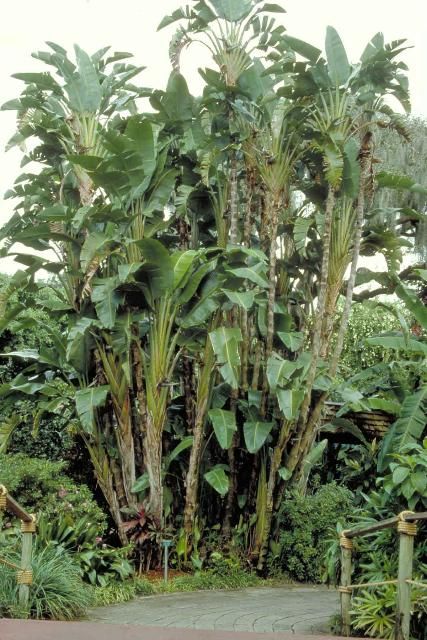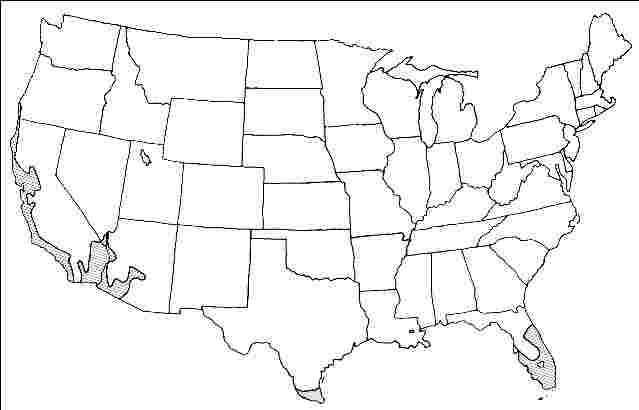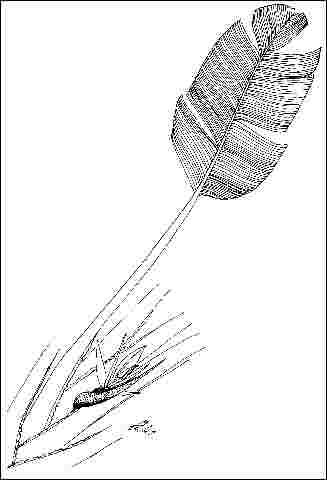Introduction
White Bird of Paradise is most often planted for its large, banana-like leaves and upright, clumping stalks which give an exotic feel to the landscape. Plants can reach 20 to 30 feet in height with a spread of 10 feet though they are often seen much smaller. The five to eight-foot-long, cold-tender leaves are arranged in a fanlike display from the erect trunks and appear much like traveler's tree. The lower trunk becomes clear of leaves and exposed as the older leaves drop off. Leaves rip along the veins as they are blown by strong winds.

Credit: Ed Gilman, UF/IFAS
General Information
Scientific name: Strelitzia nicolai
Pronunciation: streh-LIT-see-uh NICK-oh-lye
Common name(s): White Bird of Paradise, giant Bird of Paradise
Family: Strelitziaceae
USDA hardiness zones: 9B through 11 (Fig. 2)
Origin: not native to North America
Invasive potential: little invasive potential
Uses: deck or patio; specimen; container or planter; indoors
Availability: not native to North America

Description
Height: 20 to 30 feet
Spread: 6 to 10 feet
Crown uniformity: irregular
Crown shape: upright/erect, palm
Crown density: open
Growth rate: moderate
Texture: coarse
Foliage
Leaf arrangement: alternate (Fig. 3)
Leaf type: simple
Leaf margin: entire
Leaf shape: oblong
Leaf venation: pinnate
Leaf type and persistence: evergreen, broadleaf evergreen
Leaf blade length: more than 36 inches
Leaf color: green
Fall color: no color change
Fall characteristic: not showy

Flower
Flower color: white/cream/gray
Flower characteristics: showy
Fruit
Fruit shape: unknown
Fruit length: unknown
Fruit covering: dry or hard
Fruit color: brown
Fruit characteristics: does not attract wildlife; not showy; fruit/leaves a litter problem
Trunk and Branches
Trunk/bark/branches: branches don't droop; showy; typically multi-trunked; thorns
Pruning requirement: little required
Breakage: resistant
Current year twig color: not applicable
Current year twig thickness:
Wood specific gravity: unknown
Culture
Light requirement: full sun, partial sun, or partial shade
Soil tolerances: clay; sand; loam; acidic; slightly alkaline; well-drained
Drought tolerance: moderate
Aerosol salt tolerance: low
Other
Roots: not a problem
Winter interest: no
Outstanding tree: no
Ozone sensitivity: unknown
Verticillium wilt susceptibility: unknown
Pest resistance: resistant to pests/diseases
Use and Management
The interesting flowers are white with a dark blue tongue. White Bird of Paradise is ideal for entranceways for a dramatic effect or for use at poolside. Plants are not messy but ragged leaves should be periodically removed for a tidy appearance. This is a large plant and should be situated accordingly.
White Bird of Paradise grows well in full sun to light shade on moist, well-drained soil. Plants should be protected from high winds to minimize torn, ragged leaves. It will survive periods of 28°F with minimal leaf burn and will quickly recover. Prune to remove dead leaves and thin out surplus growth sprouting from the base of the trunk, if you wish.
Propagation is by division of the suckers or from seed which germinate slowly.
Pests
Scales may infest this tree.
Diseases
No diseases are of major concern.